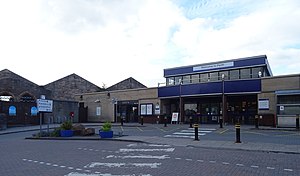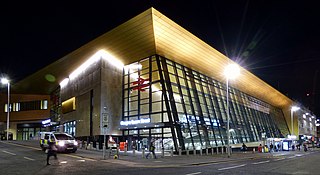
Glasgow Queen Street is a passenger railway terminus serving the city centre of Glasgow, Scotland. It is the smaller of the city's two mainline railway terminals and is the third busiest station in Scotland behind Central and Edinburgh Waverley.

The Highland Main Line is a railway line in Scotland. It is 118 mi (190 km) long and runs through the central Scottish Highlands, mainly following the route of the A9, and linking a series of small towns and villages with Perth at one end and Inverness at the other. Today, services between Inverness and Edinburgh, Glasgow and London use the line. At Inverness the line connects with the Far North Line, the Aberdeen-Inverness Line and the Kyle of Lochalsh Line. All trains are diesel-powered.

Aviemore railway station serves the town and tourist resort of Aviemore in the Highlands of Scotland. The station, which is owned by Network Rail (NR) and managed by ScotRail, is on the Highland Main Line, 83 miles 31 chains from Perth, between Kingussie and Carrbridge, and is also the southern terminus of the Strathspey preserved railway.

Inverness railway station is the railway station serving the Scottish city of Inverness. It is the terminus of the Highland Main Line, the Aberdeen–Inverness line, the Kyle of Lochalsh line and the Far North Line.

Lenzie railway station is a railway station serving Lenzie and Kirkintilloch in East Dunbartonshire, Scotland. It is located on the Croy Line, 6+1⁄4 miles (10.1 km) northeast of Glasgow Queen Street. Trains on the Glasgow to Edinburgh via Falkirk Line pass Lenzie by. The station is served by ScotRail.
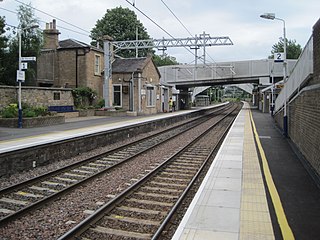
Polmont railway station is a railway station serving the village of Polmont, Scotland as well as the other Falkirk Braes villages. It is located on the Glasgow to Edinburgh via Falkirk Line and is also served by ScotRail services from Edinburgh to Stirling and Dunblane. It is the nearest station to much of the town of Grangemouth.

Larbert railway station is a railway station serving Larbert near Falkirk, Scotland.

Stirling railway station is a railway station located in Stirling, Scotland. It is located on the former Caledonian Railway main line between Glasgow and Perth. It is the junction for the branch line to Alloa and Dunfermline via Kincardine and is also served by trains on the Edinburgh to Dunblane Line and long-distance services to Dundee and Aberdeen and to Inverness via the Highland Main Line.

Dunblane railway station serves the town of Dunblane in central Scotland. It is located on the former Scottish Central Railway, between Stirling and Perth and opened with the line in 1848. It is the northernmost station on the National Rail network to be electrified.

Gleneagles railway station serves the town of Auchterarder in Perth and Kinross, Scotland.

Ladybank railway station serves the town of Ladybank in Fife, Scotland.

Dunkeld & Birnam railway station serves the town of Dunkeld and village of Birnam in Perth and Kinross, Scotland. It is located on the Highland Main Line, 15 miles 31 chains (24.8 km) north of Perth and is the first stop on the line north of there, before Pitlochry. Most services are operated by ScotRail, who also manage the station. LNER and Caledonian Sleeper also call some services here.
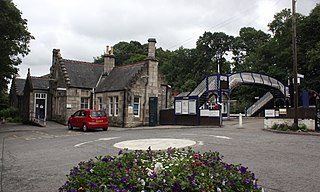
Pitlochry railway station is a railway station serving the town of Pitlochry in Perth and Kinross, Scotland. It is managed by ScotRail and is located on the Highland main line, 28 miles 21 chains (45.5 km) from Perth, between Dunkeld & Birnham and Blair Atholl.

Newtonmore railway station serves the village of Newtonmore, Highland, Scotland. The station is managed by ScotRail and is on the Highland Main Line. The station is 68 miles 62 chains (110.7 km) from Perth, between Dalwhinnie and Kingussie, and has a single platform which is long enough for a ten-coach train. It is currently the only station on the Highland Main Line to have one platform, although the former second platform can still be seen adjacent to the first platform.
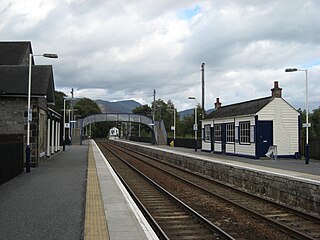
Blair Atholl railway station is a railway station serving the town of Blair Atholl, Perth and Kinross, Scotland. The station is managed by ScotRail and is on the Highland Main Line, 35 miles 9 chains (56.5 km) from Perth, between Pitlochry and Dalwhinnie. There is a crossover at the north end of the station to allow trains to turn back if the line south to Pitlochry is closed.
The Scottish Central Railway was formed in 1845 to link Perth and Stirling to Central Scotland, by building a railway line to join the Edinburgh and Glasgow Railway near Castlecary.
There have been several railway stations serving the town of Newburgh, Fife. The original was opened on 17 May 1848 by the Edinburgh and Northern Railway, on their line from Ladybank to Hilton Junction, near Perth. This station lasted until August 1906, when a larger replacement station was opened.
The Scottish Midland Junction Railway was authorised in 1845 to build a line from Perth to Forfar. Other companies obtained authorisation in the same year, and together they formed a route from central Scotland to Aberdeen. The SMJR opened its main line on 4 August 1848. Proposals to merge with other railways were rejected by Parliament at first, but in 1856 the SMJR merged with the Aberdeen Railway to form the Scottish North Eastern Railway. The SNER was itself absorbed into the larger Caledonian Railway in 1866. The original SMJR main line was now a small section of a main line from Carlisle and central Scotland to Aberdeen.
The Scottish North Eastern Railway was a railway company in Scotland operating a main line from Perth to Aberdeen, with branches to Kirriemuir, Brechin and Montrose. It was created when the Aberdeen Railway amalgamated with the Scottish Midland Junction Railway on 29 July 1856. It did not remain independent for long, for it was itself absorbed by the Caledonian Railway on 10 August 1866.
The Railways of Kinross were a local network of three rural railways which made the town of Kinross in Scotland their objective in the 1850s.
